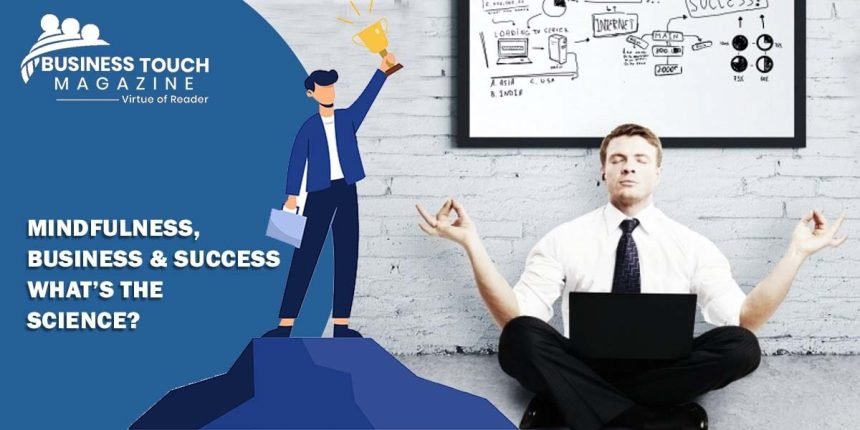If regular mindfulness practise can help us feel hopeful and optimistic even in the worst of circumstances, then it stands to reason that it can also affect the way we behave on a daily basis.
Why mindfulness matters at work.
Mindfulness generally means being fully present and engaged in the moment. It requires two specific skill sets:
- Focus (the ability to concentrate on what you are doing)
- Awareness (the capacity to dismiss distractions as they arise)
Both can be taught, and mindfulness instruction is essential for finding out how to incorporate it into your company. It’s not easy, but it’s definitely worthwhile in the end.
In the first place, practising mindfulness improves people’s moods, and a positive mood directly correlates to increased output. A healthy organisational culture fostered via the use of mindfulness practises may have a major impact on the emotional well-being of an organization’s workforce. Customers and clients might get infected as well.
Emotional intelligence (EQ), or the capacity to understand and manage one’s own and other people’s emotions, may also be improved via mindfulness practise. It’s in our human nature to let our previous experiences colour our present and future decisions on how to handle information, deal with conflict, and resolve disputes. People who are emotionally intelligent are aware of the impact that emotions like joy, worry, and tension have on themselves and others around them. Increasing our EQ allows us to think through our responses before acting, rather than reacting on the fly. Taking this approach at work may improve decision-making and lead to more fruitful approaches to resolving conflicts. Those with a high EQ are also more likely to be “transformational leaders,” which means they can inspire their teams to greatness by fostering an environment of trust and cooperation.
Whether it’s by hosting a weekend seminar with a mindfulness specialist or hosting an online mindfulness workshop, small company owners may easily include mindfulness training programmes into their culture. Instead of spending a lot of money on seminars and workshops, businesses may provide employees access to a mindfulness app like Headspace or Calm. Both applications may be purchased in bulk by companies to assist employees de-stress, sleep better, and concentrate better. And they provide analytics for monitoring employee participation. After six months of using the Calm app, I can vouch to its usefulness.
Building a mindful business
When you establish your company with a well-defined goal in mind, you’ll be better prepared to ride through the inevitable ups and downs that lie ahead. All of the choices you make for your company should be informed by your goal statement.
It may be challenging to stay true to your “why” when your company expands, technology advances, and customer demands shift. To help us stay focused and on the same page with our respective companies, we created a proprietary framework we call MAPS (which stands for “mindful,” “aggressive,” “profitable,” and “sustainable”). We think it takes the cooperation of all these factors to achieve long-term success.
Infuse core values
The book that changed the way firms and CEOs presented themselves to the world was written by James Collins and Jerry Porras and was released in 1994. Made to Last: According to the book Successful Habits of Visionary Companies, the most successful businesses in the world adhere rigidly to a set of values and an overarching mission statement known as the “core philosophy.”
The company’s “guiding principles” are its basic beliefs, while its “core purpose” is the overarching reason for the company’s existence (and hence its mission). As an example, Disney’s mission of “making people happy” is congruent with the company’s fundamental principles of “imagination and wholesomeness.” That’s why there are so many offbeat protagonists and princesses who have their happily ever afters.
As your company expands and new employees are brought on board, your guiding principles should act as a glue that brings everyone on board together, from upper management to the front lines to the customers.
- Limit distractions
While modern comforts and luxuries are a direct result of our easy access to technology, this has a downside: it constantly distracts us. Furthermore, the mental and physical costs of multitasking reduce efficiency. Even the most accomplished practitioner of mindfulness would struggle to keep concentration in the face of continual interruptions, despite the fact that mindfulness training helps nurture attention and eliminate distractions as they emerge.
We used to find a quiet nook of the library and hunker down there before our final examinations. So why don’t we just send our teams off to the metaphorical library when they need to work on a major presentation, compose a grant application, or solve complicated equations? On the contrary, we constantly interrupt them with calls, texts, and emails.
It’s not simple to enter a flow state, therefore you should make a concerted effort to eliminate the interruptions that prevent you from doing so. Obviously, not everyone has the luxury of setting aside hours each day. To the best of your ability, that is. First, test the waters with a low dose: Make it such that certain periods of the day (say, between 2 and 4 o’clock on Tuesdays and Thursdays) are particularly challenging and should be avoided if at all possible. Once the time frame has passed, it is time to evaluate the outcomes and poll the team. The Pomodoro method and Flowtime are two comparable strategies that you might suggest to your staff. The idea is to provide your employees with more dedicated work time.
- Create connection and community
It takes time and money to find and train new staff, so you want to make sure they remain around. In addition, productive workers are advantageous to any organisation. Every employee must feel that they are making a difference and making progress in the organisation, while also having the opportunity to develop their skills and acquire new ones. Having well-defined roles and responsibilities inside the company may help build trust and camaraderie among employees. To enhance empathy and interpersonal connections, mindfulness practises instruct one to devote nonjudgmental attention to both internal and exterior events.
You’ll need to come up with novel approaches to establishing trust and cultivating genuine relationships within your team as the prevalence of remote work grows and key daily gathering spots (such as around the coffee machine) become more scarce.
Consider allocating some of the money you would have spent on an office for your staff to retreats that focus on personal growth and team bonding, with an emphasis on mindfulness. More time spent together in person, even over the course of a weekend, may strengthen bonds than can be achieved via repeated Zoom chats. Your team will benefit much from the retreat if everyone agrees to put down their phones, disable alerts, and focus on the task at hand.
- Encourage healthy boundaries
Stress among workers is becoming more of a problem in modern workplaces, and mindfulness might help alleviate some of that pressure. However, it is not sufficient for businesses to only reduce stress in the office; they must also give workers with opportunities to refuel in their spare time.
Even if individuals are less inclined to use their vacation days than they once were, businesses still need to incentivize their workers to take advantage of their vacation time. Owners should set an example by limiting their own digital use and urging staff to do the same.
During your allotted time off, you may even send your messages to the rest of the team. By not giving them any reason to “check in” or give a “quick answer,” you’re showing your staff that you value their time off and their well-being. If your team is tiny, you may need to shift your attention to encouraging individual contributors to develop useful procedures instead.
You, as a sole proprietor, must be forthright with your customers from the get-go; inform them of your regular business hours, including holidays, and of the typical amount of time it takes you to respond to messages sent by email or the phone.




